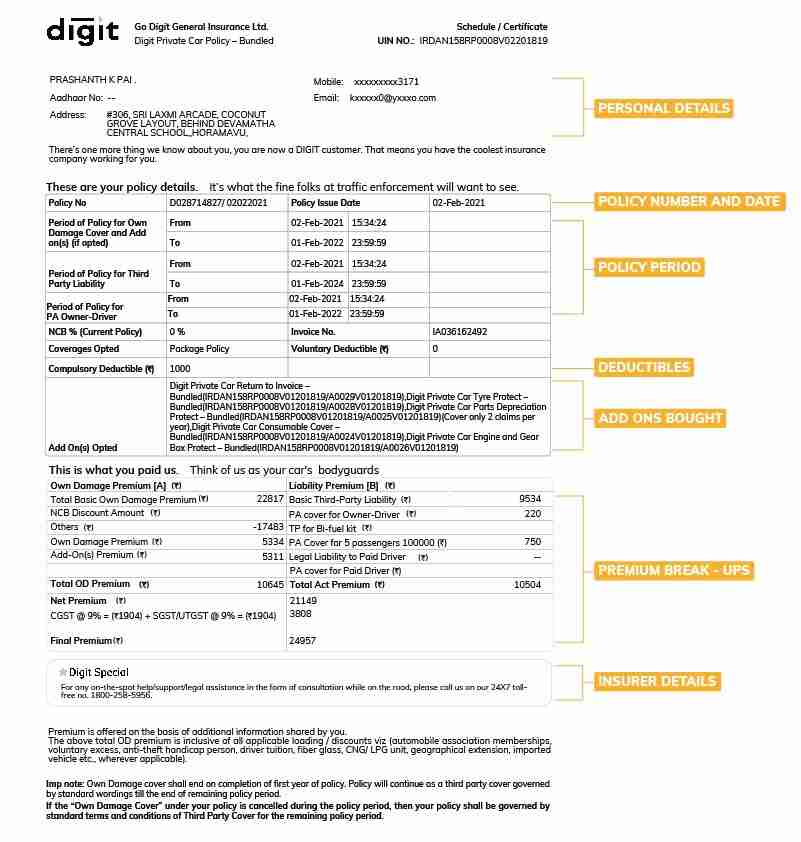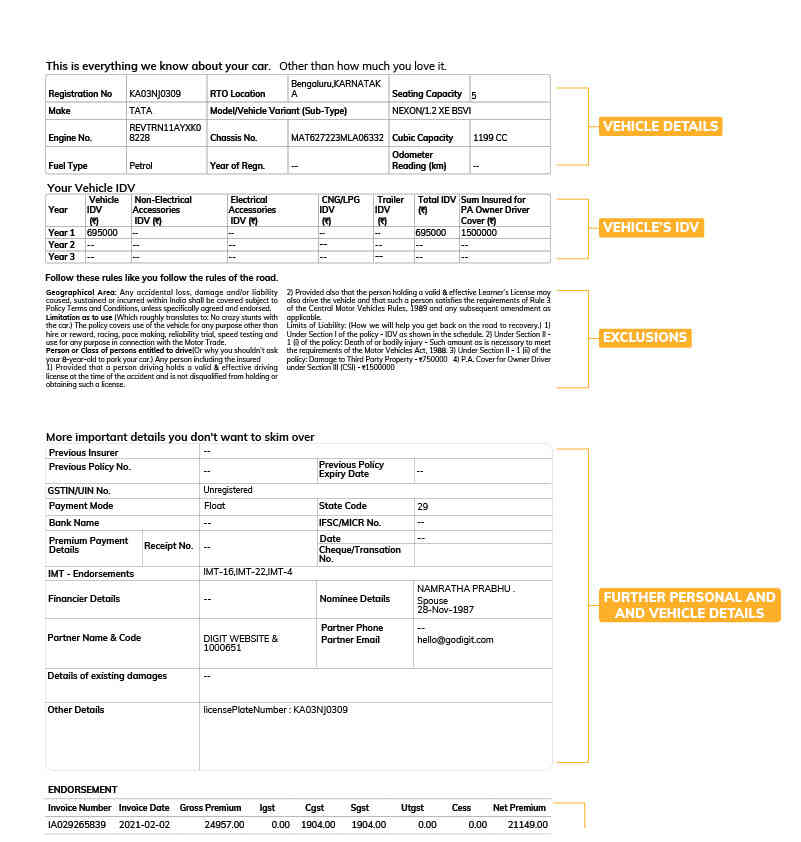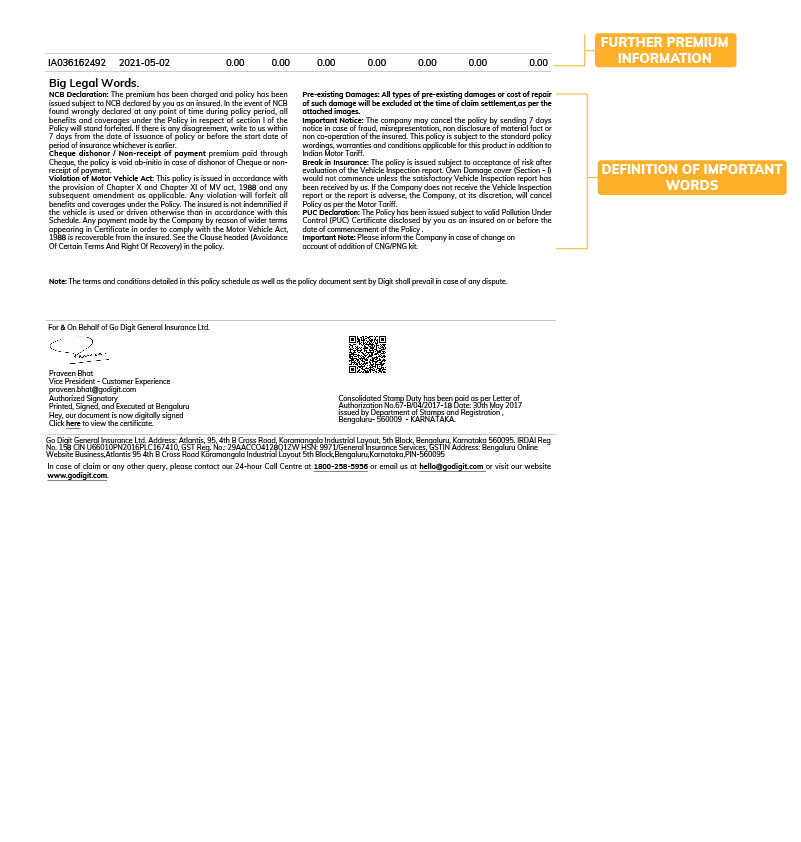9000+ Cashless Garages
96% Claims Settled (FY 24-25)

9000+ Cashless Garages
96% Claims Settled (FY 24-25)


When you have got a new car, and you have protected it with a car insurance policy, you might be feeling a little overwhelmed with all the complicated terms in your own policy document.
But not to worry. We understand that it is very important for you to understand your car insurance policy, so we’re here to help you know which details to check when going through your policy and what to look out for so that you have no trouble when it comes to knowing your coverage and raising a claim.
So, whether you have a third-party only policy, a comprehensive policy, or an own damage policy, here are some things you need to check when going through your policy documents.
If you need further help, you can also go through our insurance dictionary, where you can learn more about all the terms used.
The most important thing to read and understand in your car insurance policy is its terms and conditions. For example, while making claims, you might have to pay a deductible amount out of pocket, or in the case of a third-party policy, damages to your own vehicle won’t be covered. Knowing the terms and conditions can be very helpful at the time of making a claim.
Always remember to go through the policy wordings to check what is covered by your car insurance policy. Different types of car insurance, such as a third-party only policy, a comprehensive, or an own damage policy, will each have different coverages. Here are some things to look out for:
|
Third-Party Policy |
Own-Damage Policy |
Comprehensive Policy |
|
Covers damages and losses to any third-party person, or property |
Covers for your own car’s damages and losses due to accidents and collisions, natural calamities, fires, and thefts |
Covers both third-party losses and liabilities as well as any damages to your own vehicl |
It is just as important to know what is not covered under your car insurance policy. Generally, most car insurance plans in India exclude coverage for consequential damages to the vehicle, any contributory negligence, or disobeying traffic rules by driving without a license or under the influence.

Deductibles are the amount you need to pay out of your own pocket at the time of a claim before your insurance company pays for the rest. There are two main types, compulsory and voluntary.
A compulsory deductible is set by the insurance company when you purchase the policy, so be sure to check this amount in the policy document. You can also opt for an additional voluntary deductible, which can bring down your car insurance premium.
Your car’s Insured Declared Value, or IDV is its current value, and also the maximum amount the insurance company will pay in case of a total loss or total damage. It is calculated by adjusting the manufacturer’s selling price by the depreciation of the vehicle.
It is important to check that the IDV of a vehicle is correctly calculated, as it will affect both your sum insured, and the premium amount. If your insurance providers let you choose your IDV, ensure it is noted correctly.

Remember to check your policy number, i.e., the unique number that is associated with your car insurance policy. This number will be used at the time of claims, support requests, and in case you get into an accident, and if you have damaged a third-party’s vehicle/property, you will need to know this policy number to share with them so that they can raise a claim under it.
Finally, check the car insurance policy document for the start date and end date of the policy. It is important for you to know these dates so that you can remember to renew the policy on time.
Ensure that you know the claim process of your insurer. This way, when you’re in trouble, you won’t have to spend precious time going through the policy documents to check what to do.
Understand the situations where you can make a claim, the documents required to file a claim, as well as time limits within which you can do so. Also, remember to note the network garages where you can avail of cashless car repairs.
When you get your car insurance policy, remember to check your personal details. Make sure that your name, address, and contact information (like your number and email) are all correct and up-to-date. Additionally, ensure that the details of your vehicle are also correct, including the make and model, and the vehicle registration certificate.
Otherwise, your insurer might not be able to get in touch with you, and there could be some confusion at the time of claims.


You must also make note of the contact information of your insurer. Check for details like their phone numbers, addresses, and email ids. This is very important in case you need to get in touch with the insurance company at the time of a claim, if you need any help, or in case you have further queries about your policy.
Let us take a quick look at an example of a policy document from Digit, and where you can find all these details:



If you wish to look at a more detailed coverage of the policies, you must go through the policy wordings. You can see some examples below: